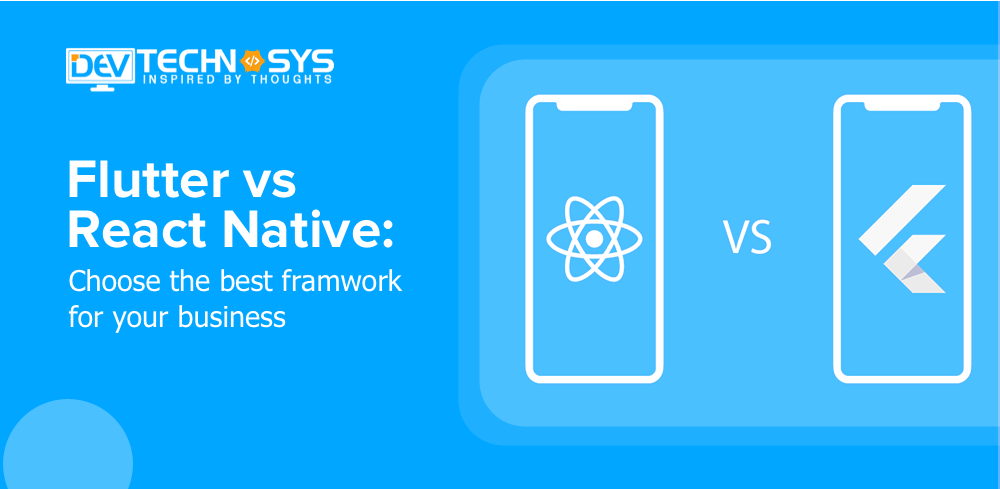
Because this century is rich with innovations, the more convenient the platform, the more favored it is. People normally seek the simplest way possible, thus programmers create simple platforms with the assistance of which ordinary people with no profound understanding of a programming language can simply construct websites and apps. These platforms are sometimes free to use, but most of the time they are not. Flutter is an example of a premium platform. As the need for mobile apps grows, developers are looking for platforms that will allow them to simply construct frameworks. React Native is one such platform.
Flutter v/s React Native
The distinction between Flutter and React native is that Flutter is a Google-built User Interface (UI) toolkit for creating appealing and user-friendly mobile apps, whereas React native is a free software javascript framework created by Facebook. Because React Native uses javascript, users do not need to compile code for each platform because the same code can be executed on both Android and iOS. In Flutter, the code is automatically compiled based on the user’s specifications.
This makes it more desirable because it does not slow down throughout this procedure. Because React Native and Flutter are free as well as open-source platforms, users may make whatever modifications they want for free. Flutter is more organized than React native.
Running hybrid apps can sometimes slow down a React native app, however, in the case of Flutter, it has no effect on the runtime, giving the applications greater native performance. Development in Flutter is done by Flutter itself, but testing in React native requires the use of third-party technologies. Flutter supports several methods of testing, including unit testing, widgets testing, as well as integration and system testing.
A Glance At Flutter
There was no Flutter in 2015, but there was a so-called browser war. Chrome’s developers were considering ways to improve their browser. As a result, the team decided to remove CSS from the browser engine, which resulted in a significant gain in speed. Recognizing that it had to be used in some way evolved into what we now call Flutter.
Google released Flutter as an open-source framework for scripting and developing native apps for Android and iOS. Flutter is still in its early stages, having been formally introduced in December 2018 as the first stable version 1.0 at the Flutter Live event. Flutter combines the simplicity of development with native-like performance while retaining visual consistency across platforms. Dart, Flutter’s programming language, was designed to be a substitute for JavaScript. Most significantly, Flutter is an open-source project that is entirely free to use.
There are several elements that are extremely valuable to the business, such as foundation reliability, efficiency, a promise of effective assistance, and technological and product innovation. Any issues or deficiencies in any of these areas may result in hazards, including direct and indirect financial losses.
You can hire Flutter app developers because Flutter developers are more productive, it takes less time to produce an application, which implies that when compared to other programming languages and frameworks, Flutter apps are created faster and hit the market earlier with equivalent effort. As a result, the less coding and maintenance work required, the faster the time to market.
A Glance At React Native
If you want to get started with native mobile app development, the react native framework is the best option to utilize. You may use JavaScript to construct mobile applications with react native, often known as RN. In most cases, Java is used to construct an Android mobile app, whereas Swift or Obj-C is used to develop an iOS app.
You can use React Native to create mobile apps that work well on both platforms. Furthermore, because coding is done in the same language regardless of platform, development time is greatly reduced. React Native is an open-source framework developed by Facebook in 2015. ReactJS, often known as React, was also introduced by Facebook for mobile programming.
When React Native was first introduced, it was thought to be unsuitable for business use. It was still impossible to create native mobile applications. Nonetheless, react-native has progressively grown in popularity, gaining community backing and market share.
You can hire react native app developers to create highly functional mobile apps. When you create a mobile app using React Native, you naturally create an app that works on both iOS and Android. As the app’s code is compiled, it is reduced to native Java and Swift code. Before React Native was built and released, Facebook produced a mobile app to test the platform’s feasibility. It was successful in assisting the developers in creating an eye-catching mobile app for the social networking platform.
Main Differences Between Flutter And React Native
- Flutter has a testing tool that does many sorts of testing like integration testing and widget testing, among others. Third-party tools are used for testing in React native.
- React native employs Javascript, which eliminates the need for users to create distinct code for multiple platforms, however, it might be sluggish when working with hybrid apps. However, because Flutter employs a C/C++ library, it does not slow down easily.
- In comparison to Flutter, React native has significant community support.
- Flutter is well-organized, with a plethora of widgets to choose from. However, React native is not well-organized and requires third-party technologies to make apps appealing.
- When compared to React Native, Flutter performs the superior compilation and does not slow down. When it comes to hybrid apps, React native slows considerably.
Conclusion
As technology advances, people look for the simplest ways to complete tasks quickly. Flutter and React Native merely process and provide user-defined programs via which any mobile app development company or developer may create appealing desktop and mobile applications. Flutter is more structured and has more inbuilt tools, whereas React native utilizes third-party tools. However, this does not make React native less favored because it allows other apps to prove themselves.
Flutter and React native are both free and open-source, which makes them more appealing because users may freely adjust and specify their own needs. These are becoming more complex with each new version that is published. Both platforms were created by technologists, so there is no need to be concerned about security or privacy.
Author:

Tarun Nagar is the Founder & CEO of Dev Technosys, a global ranking mobile app development company. With 10+ years of experience of enabling then Startups which are now global leaders with creative solutions, he is differentiated by out-of-the-box IT solutions throughout the domain. He is known for his visionary qualities and adaptability for technology and trends, passionate as he is in every aspect dedicated to making IT simple, accessible and approachable for business enterprises.
https://www.facebook.com/devtechnosys/
